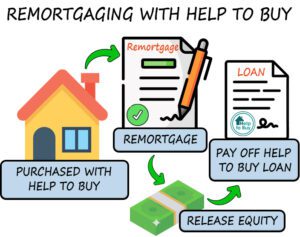Explore the possibility of remortgaging with Help-to-Buy home equity scheme with our helpful guide.
Between April 2013 and December 2022, a staggering 383,903 properties were purchased with Help to Buy: Equity Government Loan schemes in England alone – of these 325,054 were acquired by first-time buyers – totalling an impressive total value of £24.4 billion in equity loans issued under these schemes. Help to Buy Equity Loan is a government loan designed to be part of your deposit when purchasing a new-build home. Interest-free for the first five years, then gradually rising according to the retail price index after that point.
The Help to Buy equity loan scheme closed for new applicants on 31 October 2022. Now that many of the scheme participants have to start paying interest and their fixed-rate mortgage deals are ending, they could be at risk of switching over to their lender’s standard variable rate. As of February 2024, the average SVR stands at an astronomical 8.19%. This is a significant leap from 4.40% in December 2021, making a timely Help to Buy remortgage even more important.
Many of the government scheme customers often wonder if a Help-to-Buy remortgage is possible for them and whether developer consent is required before remortgaging. To answer these questions and if your current deal is coming to an end, read this helpful guide, and get in touch for fee-free independent mortgage advice.


Why Consider a Help To Buy Remortgage?
There are many reasons a Help To Buy homeowners remortgage, below we highlight some of the main reasons why you should consider it:
- If the expiry of your fixed-rate mortgage deal is less than 6 months away.
- You are looking to switch to a mortgage deal that is either less expensive or offers more flexibility.
- You are planning to fully settle your equity loan.
- Your property value has increased, therefore you want to release equity to borrow more money or secure a mortgage with a lower loan-to-value ratio.
Is a Help-to-Buy Remortgage Possible?
Indeed, remortgaging a Help To Buy loan property is often possible. Like standard fixed-rate mortgages, interest rates usually remain fixed for an agreed-upon duration, ranging between 2-5 years.
When your fixed-rate term comes to an end, you will switch to your lender’s standard variable rate, which is usually much higher and can fluctuate leading to high and unpredictable repayment amounts.
Remortgaging to a new fixed-rate deal, whether that be with your current lender or a new lender, usually makes sense. Even though interest rates might have increased since you took out your original mortgage loan, your financial situation might now be stronger due to increased equity. Either way, going onto your lender’s SVR is so much higher, fixing in a new deal to avoid this often is your best option.
Everyone’s financial situation and property goals are different, which is why it’s so important that you seek advice from an expert before hastily changing deals without first considering whether more cost-effective options may exist elsewhere.
Can You Remortgage a Help-to-Buy Home if Your Financial Situation Changed?
Yes, but not necessarily. When determining your remortgage affordability, mortgage lenders will look at factors such as:
- your income stability
- your debt-to-income ratio
- and how close you are to your retirement age
This is for lenders’ due diligence as they assess whether remortgaging is within your financial means.
Even if your financial circumstances have worsened, that doesn’t necessarily mean that you can’t remortgage; rather, it may necessitate searching the market again for a specialist lender with more accommodating terms – this is where mortgage brokers come in handy.
Did you know some brokers can complete your remortgage for free? Like YesCanDo Money, these are called fee-free mortgage brokers.

What Options Do I Have When Remortgaging My Help To Buy Property?
It’s essential to explore all available remortgaging options when considering refinancing a Help to Buy property:
- Repay Your Help to Buy Loan: Remortgage to pay off Help to Buy can both clear out your existing mortgage and repay all equity loan balances in full – giving you complete ownership.
- Secure a Lower Interest Rate: Remortgaging may help you avoid your lender’s Standard Variable Rates (SVR), and secure lower interest rates or better terms without negatively affecting your equity loan. Whether you choose to remain with your existing lender or switch to a new lender, remortgaging can provide significant cost-cutting potential.
- Extending Mortgage Term: Prolonging the length of your mortgage term may make mortgage payments more manageable by spreading them out over a longer period. However, remember this could increase the total interest paid over time.
- Partial Help to Buy Repayment (Staircasing): Remortgaging can help pay off part of the equity loan and thus decrease the government’s stake in your home, taking one step closer to full ownership without needing to pay it all off at once.
- Debt Consolidation: If you have other debts, consolidating them with your mortgage when remortgaging may help lower monthly mortgage repayments; however, be wary as it could extend the duration of the debt.
Each option carries its own set of considerations and potential repercussions for your financial future, so consulting a mortgage advisor from a fee-free brokerage such as YesCanDo Money may offer invaluable guidance tailored specifically to your unique circumstances.
Do You Have To Pay Off Your Help-to-Buy Equity Loan When Remortgaging?
It’s not always required to pay off your help to buy loan when you remortgage, but it becomes necessary when you sell your property. It’s common for homeowners to remortgage for an amount that covers the Help-to-Buy loan repayment, thus freeing them from the loan or enabling them to sell the property as they wish.
Some mortgage lenders will have certain criteria that may prevent you from remortgaging with them if you will still owe a Help to Buy loan after remortgaging. This is usually because an additional financial commitment puts the lender you’re looking to remortgage with at risk of not receiving payment on time. It comes down to the individual mortgage lenders’ requirements but this is certainly not the case for every lender.
Remortgaging a home bought with a Help to Buy loan is different from remortgaging a traditional property. For instance, if you need to repay 20% of your loan within 12 months, you must consider this when choosing your new mortgage amount and terms. You have the option to either increase your borrowing to fully repay the Help to Buy loan or switch to a new mortgage deal, using either your income or savings for the repayment.
Remortgaging to Repay a Help to Buy loan
If you’re considering remortgaging to pay off your loan, it’s important to figure out if the higher monthly repayments are manageable for you. A mortgage broker can help by comparing your income and expenses and estimating your monthly payments with different lenders.
While extending your mortgage term can lower your monthly payments, remember that it also means you’ll pay more in interest over time compared to choosing a shorter term with higher monthly payments.
Staircasing to Settle a Help-to-Buy Loan
Leveraging the equity or “value” accumulated in your home to settle your Help-to-Buy loan is another avenue. Should your property’s value have appreciated, refinancing based on this new value to access the equity for repaying the loan, either partially or in full, is known as staircasing. The Help-to-Buy scheme permits a minimum repayment of 10% at a time.
Before this decision, it’s advisable to calculate your new loan-to-value (LTV) ratio, which is the loan amount in relation to your property’s value. A select number of lenders might permit remortgaging with a high LTV of 95%, though many prefer a lower LTV of 80-90%, which could also aid in meeting criteria for lower interest rates.
For example: Imagine purchasing your home for £200,000 using a Help-to-Buy equity loan covering 20% (£40,000), then over time the property value has appreciated to £250,000; now is the perfect opportunity to remortgage based on that higher figure and use any equity you access as repayment for the Help-to-Buy loan.
Repaying 10% (£25,000) through staircasing could lower your loan-to-value ratio and make you eligible for more advantageous mortgage terms and rates of interest. For instance, adding the £25,000 repayment amount and refinancing would create a new LTV calculation based on £250,000 property value which might open doors to better refinancing options.
Is Developer Consent Required to Remortgage with a Help-to-Buy Loan?
If you are still making payments toward your Help to Buy loan, obtaining a Deed of Postponement is essential. Send this document directly to your Help to Buy administrator; your Help to Buy agreement should provide all the details.
Your solicitor plays an essential part in this process, as they are responsible for submitting the Deed of Postponement request. Therefore, you must discuss your plans to remortgage early with them so they can prepare everything correctly. In addition, don’t forget to consider their fees when considering the financial implications associated with remortgaging as this will allow you to manage your budget better and prevent any unexpected expenses during this process.
Costs Associated with Refinancing a Help-to-Buy Property
When considering refinancing a Help to Buy property, it’s essential to take account of various significant expenses, which could impact your financial plans significantly. Here is an updated list with your requested details:
- Royal Institute of Chartered Surveyors Valuation Report (RICS): Essential for determining your property’s current market value and therefore your Help to Buy loan repayment amount, this report costs between £160 to £600 depending on which level of survey is chosen – remember, repayment of this loan should take account of its current worth rather than original purchase price.
- Administration Fee: The firm managing Help to Buy equity loans, commonly known as Target, charges an administration fee, generally around £120.
- Solicitor’s Fees: Solicitor fees typically range from £459 to £900 (inc VAT). These may increase if adding another partner through equity transfer or refinancing by taking out a new mortgage loan.
- Mortgage Broker Fees: When hiring a mortgage broker can assist in finding a cost-effective lender, it is worth remembering that many providers such as YesCanDo provide their services free of charge – meaning no hidden charges for organising your remortgage process will incur. This can be especially helpful in avoiding Early Repayment Charges that apply if exiting early from an agreement; brokers can advise whether it would be smarter financially to wait or switch lenders immediately.
Careful consideration of these costs will allow you to navigate the remortgaging process more smoothly and make informed financial decisions regarding your Help to Buy property.
Instrusting a Mortgage Broker To Find The Best Help to Buy Remortgage Lender
Searching through vast number of UK mortgage lenders – including the well-known high-street banks and building societies – becomes much simpler when using a specialist broker like YesCanDo Money for fee-free services. Did you know there are over 95 lenders in the UK!
Our team will assess your current situation before providing a tailored list of Help to Buy mortgage lenders that match up best with your financial needs, we will be able to calculate how much equity you can release. We aim to eliminate time-consuming online comparison methods where generic quotes often don’t match up properly with individual financial situations.
Reach out to YesCanDo Money today at 033 0088 4407 or through our contact form for transparent, reliable guidance and support for Help to Buy remortgages – our advisors are experts at Help to Buy remortgage solutions. We aim to find you a cost-effective mortgage solution tailored specifically for you.
Frequently Asked Questions
What Is the Difference Between a Fixed Rate Deal and a Variable Rate Mortgage?
A fixed-rate deal locks in your mortgage interest rate for a set period, ensuring consistent monthly payments regardless of market changes. In contrast, a variable rate mortgage means your interest rate can fluctuate based on the lender's standard variable rate (SVR) or other rate benchmarks, leading to potential variations in your monthly repayments. Fixed-rate offers stability and predictability, while variable rates can provide savings if rates decrease but also risk higher payments if rates increase.
What Happens After 5 Years With Help To Buy?
After the initial 5-year period, the interest-free grace period on the Help to Buy equity loan concludes. Subsequently, you begin to incur interest charges on the loan amount.
Can I Move My Help To Buy Mortgage?
Yes, transferring your Help to Buy mortgage to another property is possible, subject to obtaining consent from both your lender and the Help to Buy agency involved in your region.
Can You Rent Out A Help To Buy Property After 5 Years?
Generally, renting out your Help to Buy property isn't permitted, even after 5 years, unless you have fully repaid the equity loan or received specific permission.
Is It A Good Idea To Remortgage My Help To Buy Property?
Remortgaging your Help to Buy property may be beneficial if it leads to more favourable rates, helps repay equity loans more quickly, or better fits your finances by altering mortgage terms.
Do I Have To Pay For A Valuation When Remortgaging?
For remortgaging Help to Buy properties, a RICS-certified chartered surveyor valuation report is required to calculate equity loan repayments, despite some lenders providing free valuations.


